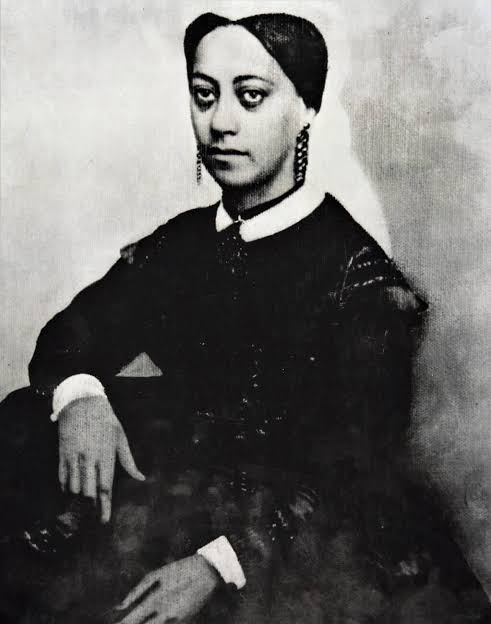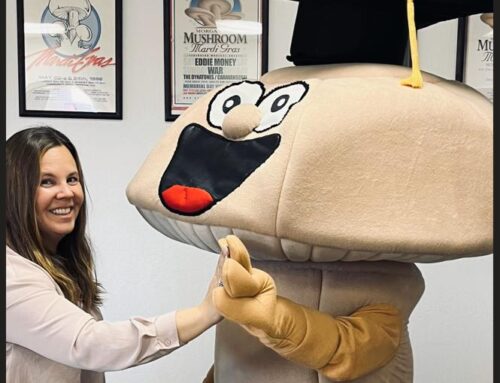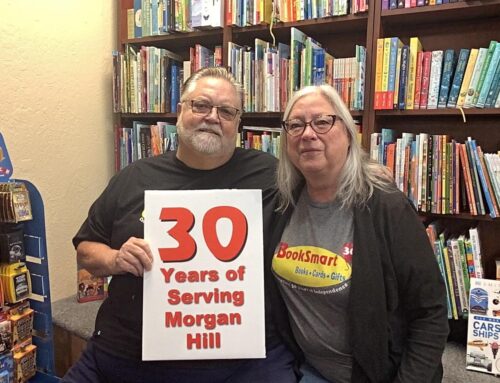Former mayor Beth Wyman wrote original version nearly 30 years ago
![]()

Photo by Marty Cheek
Toni Julian, left, and Beth Wyman with a copy of the book.
By Marty Cheek
A pioneer of local history has become a pioneer of modern publishing. Longtime resident Morgan Hill resident Beth Dunham Wyman recently dusted off and digitized her definitive biography of Hiram Morgan Hill.
 She penned the chronicle of his life 30 years ago and her good friend Toni Julian helped her in the initial publication of the book. With Julian’s help again, she recently used artificial intelligence and Amazon self-publishing to re-introduce new audiences to the town’s storied namesake.
She penned the chronicle of his life 30 years ago and her good friend Toni Julian helped her in the initial publication of the book. With Julian’s help again, she recently used artificial intelligence and Amazon self-publishing to re-introduce new audiences to the town’s storied namesake.
Wyman’s book is titled “Hiram Morgan Hill: The Man, Not the Mountain.” It’s available for $22 on Amazon’s print-on-demand online service.
Many visitors and residents mistakenly believe that the large mountain west of the city is called Morgan Hill and that the town was named after it, she said. Hiram Morgan Hill is the southerner whom the city was actually named after. That explains the subtitle.
The mountain is actually called “El Toro” — and in past years it was also known as “Murphy’s Peak.”
“I’m sure everybody who moves here does not know much about the name of the guy who gave our town its name,” Wyman said. “It’s natural to think it’s the name of the mountain.”
Thirty years ago in the book’s first run, Wyman came to Julian, who had a marketing communication firm then. The author asked for her help in turning the manuscript and photos into a paperback. She typed the book and brought it to a typesetter who made galleys. It was a painstaking manual process at a time before there were layout software on computers.

Villa Mira Monte was the South Valley country estate ranch home built by Morgan and Diana Hill. Photo by Marty Cheek
With modern technology, the process of bringing the book’s layout up-to-date was much simpler. Artificial intelligence enabled Julian to take scratchy photos more than a century old and “clean” them to bring out a fresher look.
“The entire heart of the book is exactly what it originally was, what Beth wrote word for word, to preserve that history,” Julian said. “We didn’t have any of the original art, but her son, Jeff, found the photographs in frames in storage. These photos were framed very professionally and I had to ‘jackhammer’ them out. Then I scanned them or took photos of them. And then I put them through this AI app to make them clearer.”
Wyman’s interest in local history drove her passion in studying the story of Hiram Morgan Hill. She grew up on a wheat field in central Kansas and moved to California with her family in 1940. In 1960, she moved to Santa Clara County and made a home in Morgan Hill in 1970.
In 1982, she earned a master’s degree in history at San Jose State. She titled her thesis “The History of Morgan Hill, California: Indians to Incorporation.” As an educator, she taught historical preservation at SJSU for 20 years. She served as a board president of the Morgan Hill Historical Society for many years. She was elected to the Morgan Hill City Council in 1978 and became the city’s mayor in 1982.
The photo on the cover of Wyman’s new version of her history book shows Hiram Morgan Hill as a man of about 30. His face is superimposed in front of the Villa Mira Monte estate, a Queen Ann-style Victorian home situated north of what is now downtown Morgan Hill.
Hill was a handsome teenager from the Mississippi River town of Girardeau, Missouri. He came to California in the 1870s to seek his fortune. He and his sister, Sarah Althea Hill, were both orphans and each had inherited $20,000 (about $500,000) from their parents.
Click HERE to order the book Hiram Morgan Hill: The Man, Not the Mountain on Amazon
“His grandma kicked him out because he was in love with someone that she didn’t approve of,” Wyman said. “She told him he had to leave. His sister followed him to San Francisco. She was more interesting than he was.”
Hill discovered an exciting new world in San Francisco. He found a job as a bank employee, and he also did a side gig as a clothes model at the Palace Hotel for the haberdashery Bullocks and Jones.

Mary Ellen “Mammy” Pleasant
In 1880, he met a young woman named Diana Helene Murphy, the daughter of Daniel Murphy, one of the largest landowners in the world. The courtship caused tension in the couple. Daniel forbid Diana from marrying the debonaire man, but they secretly married July 31, 1882.
“He was considered ‘fast’ by Daniel Murphy who thought of him as kind of smooth and fast and didn’t want his daughter to associate with him,” Julian said. “I guess he got around a little bit.”
When Daniel died of pneumonia two months later in Elkhorn, Nevada, Diana inherited 4,900 acres of the 8,927-acre Rancho Ojo de Agua del La Coche, a former Mexican land grant. The land makes up much of Morgan Hill in the present day. (Ironically, Hiram and Daniel were buried next to each other at the Santa Clara Mission cemetery.)
In 1886, the Murphy couple built a country estate called Villa Mira Monte on the property as a home for them and their friends to enjoy when they wished to get out of the bustle of San Francisco. The home at 17860 Monterey Road is now a city property managed by the Morgan Hill Historical Society.
When the Murphy guests wished to stop at the home, they would ask the train conductor to stop at the “Morgan Hill Ranch.” Over time, the name got shortened to “Morgan Hill.” The railroad had originally put up a sign at the depot a mile south that read “Huntington Station,” but the name of the pioneer stuck and so the city came to be called after him when it was incorporated in 1906.
Wyman’s book includes several chapters describing people in Hiram’s life. Among them is the soap opera stories of Diana after their divorce and the tragic romantic tale of their only child Diane. Another chapter describes the national scandal of Hiram’s sister Sarah Althea Hill involving a secret marriage with multi-millionaire U.S. Sen. William Sharon, a killing with a gun, and a violent schizophrenia diagnosis that put the woman at age 41 in the California Asylum in Stockton.
Also involved in the scandal as a close friend of Sarah Hill was a historic character named Mary Ellen “Mammy” Pleasant. A chapter in Wyman’s book is devoted to her fascinating life as a Gold Rush entrepreneur in San Francisco. She made much of her fortune as a real estate magnate and is considered the first self-made millionaire of African-American heritage. Much of her wealth went to help slaves escape on the Underground Railroad. She served as a friend and financial  supporter of John Brown and was highly regarded by him and other abolitionist. A monument at her Napa grave proclaims her as “The Mother of Human Rights in California” for her work in civil rights in the state.
supporter of John Brown and was highly regarded by him and other abolitionist. A monument at her Napa grave proclaims her as “The Mother of Human Rights in California” for her work in civil rights in the state.
The small book is filled with plenty of stories of what life in the Old West was like in the South Valley region of Santa Clara County. It provides a glimpse of the society through the life of a California pioneer who gave his name to what is now a Silicon Valley community.
“People who are interested in history — local history — will find this book interesting,” Wyman said. “A lot of people aren’t interested in history, but those who are who live in Morgan Hill will find it fun to discover the story of Hiram Morgan Hill and his life.”






